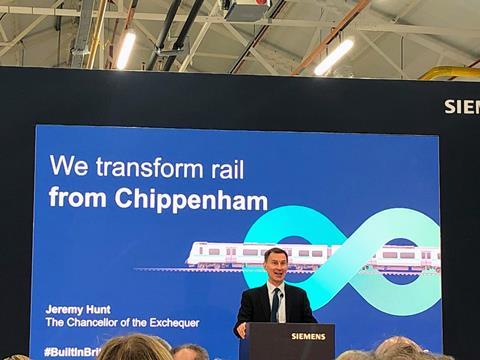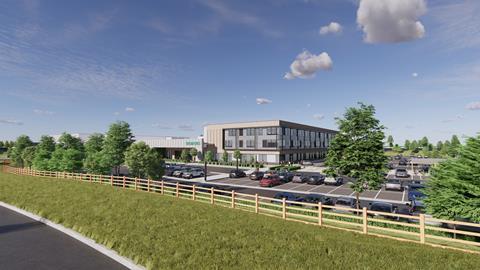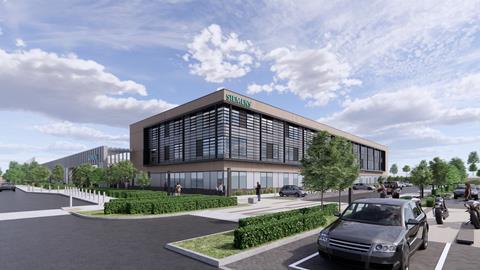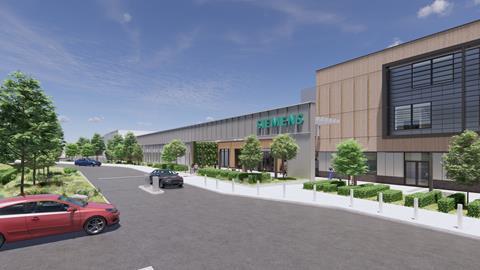
UK: Siemens Mobility has announced plans to relocate its existing rail control and signalling factory in Chippenham to a newly built site on the edge of the town by the end of 2026.
The move was announced on March 4 at a ceremony in the factory attended by Chancellor of the Exchequer Jeremy Hunt and Network Rail Chief Executive Andrew Haines, along with senior management from Siemens Mobility and local dignitaries.
Hunt said the investment in Chippenham was in line with the current government’s focus on developing advanced manufacturing jobs which would be ‘high skill and high wage’. He insisted that despite last year’s abrupt cancellation of the remaining phases of High Speed 2, the government recognised the need to ‘modernise our railways’ to help UK competitiveness.
‘We are not turning our back on upgrading our transport system’, he stressed, despite the impact of what he termed ‘a post-pandemic transition period’ on industries such as rail.
Signalling heritage

Operated by Siemens since 2013, the Chippenham site has a long and distinguished heritage of supplying railway components and equipment, with a particular focus on signalling.
The factory was established by signalling contractor Evans O’Donnell in 1897, and passed through various owners, including being acquired by the Westinghouse Brake & Signaling Company, which in turn became Invensys. This business was then taken over by Siemens.
The company says that the relocation to the new site approximately 3 km to the south will enable it to create a truly modern and sustainable factory and research hub.
Export ambition

Describing the news as ‘a day for the history books’, Siemens Mobility Chief Financial Officer Karl Blaim said the company expected the new factory to be the ‘most modern signalling facility not just in Europe, but in the world’. Up to 50% of the output of the site would be destined for projects outside the UK, he added.
Rob Morris, joint CEO of Siemens Mobility UK, added that there would understandably be ‘nostalgia’ when the company leaves its town centre site, but that in the future ‘every line of code, every component we produce would be a testament to the people of Chippenham’.
Reflecting its long tradition in signalling innovation, the factory produces an array of components for centralised traffic control, legacy signalling equipment including relays and interlockings, as well as electronic components to support digital train control technology such as ETCS and CBTC.
According to Morris, its remit is now expanding to include components for electrification and telecoms, reflecting in part the need to move away from GSM-R. ‘Two-thirds of UK signalling assets are expected to be life-expired in the next decade’, Morris said, suggesting that a strong domestic market would underpin Siemens’ investment in Chippenham.
Acknowledging a turbulent period for rail investment, he welcomed the agreed five-year plan for Network Rail signalling renewals, even if the long-term roadmap for ETCS roll-out beyond the current East Coast Digital Programme remains unclear. ‘Chopping and changing does not help anyone’, he emphasised.
Looking at the relationship between Chippenham and the large signalling and train control production facility at Braunschweig in Germany, Morris said the company had ‘ambitions’ to introduce technology being developed there in the UK, such as the ‘interlocking in the cloud’ approach now being deployed by Siemens to underpin the Norwegian ETCS deployment.
‘The British rail network is much older and much more complex’, he cautioned. ‘We want to bring that kind of technology in, but we have to work with our clients to agree a migration strategy.’
A modern production facility

Forming part of the SouthPoint Business Park, the complex will feature an office built to the BREEAM ‘Excellent’ sustainability standard. The production and warehouse areas will meet strict sustainability criteria, Siemens says, and these will be evaluated across various categories including energy, water, waste, health, well-being and materials.
The on-site offices are to be designed to provide a modern, welcoming work environment to enable better collaboration and innovation. The interior will be modelled to account for the ‘new normal’, with many open and collaborative and meeting spaces, better facilities, relaxation areas and improved technology. The site, designed to blend in with its surroundings, will undergo an ecological assessment aiming for a 10% net increase in biodiversity through the planting of native plants and the creation of wildlife habitats.
Siemens says the existing factory is to close in 2026, with no interruption to production. All 800 staff are to transfer to the new site, which is likely to occupy a slightly smaller footprint.



